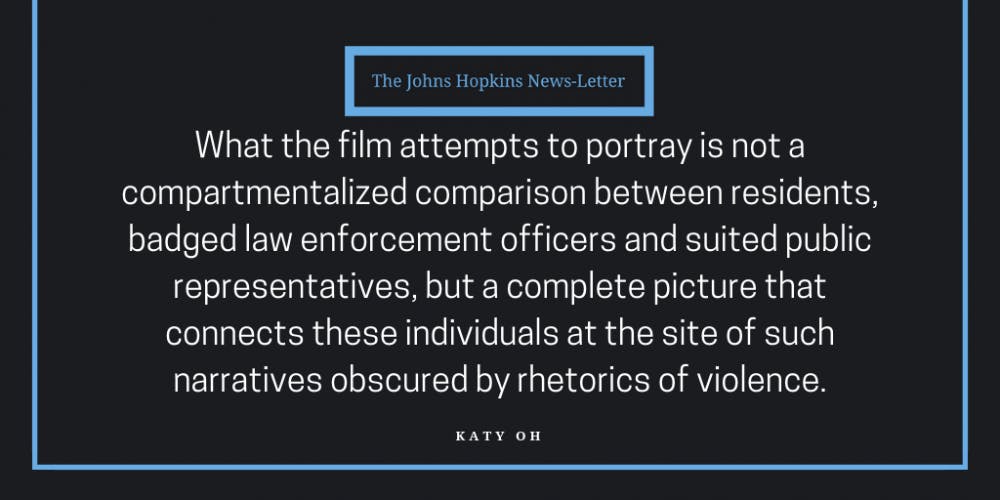The Parkway Theatre is currently screening Charm City, a documentary produced by Marilyn Ness that depicts the streets of Baltimore. She highlights a city that is too often overshadowed by the media’s dominating political discourse about sensitive topics on crime, police brutality, gun violence, poverty and race.
Charm City, however, takes us to the core of these problems and provides powerful insight into neighborhoods in Baltimore, where these recurring issues are unfathomable and everyday realities for its residents.
As a Hopkins student, watching Charm City was like realizing that my missing, high prescription glasses had been sitting on my forehead the entire time.
It has been about a year since I’ve come to Baltimore, but the Baltimore I’ve associated with has been exclusively limited to places like Charles Street, St. Paul Street, Hampden, the Inner Harbor and Mount Vernon.
And as a California native, the Baltimore that I’ve described to my friends and family back home — a city characterized by colorful row houses and brick streets running down blocks of bustling activity — has, upon reflection, been an embarrassingly simplified juxtaposition to the suburban west coast.
And while this description still holds true, it was nothing close to the Baltimore located a few minutes down from campus, a place with one of the highest homicide rates in the country.
Charm City is a documentary that you cannot comfortably watch while eating a bag of popcorn. The film exposes a pathetic truth about our system that makes your stomach turn.
At the same time, to simply say that not much is being done within the system discredits the empowering work of people who are rarely portrayed in mainstream media: Clayton “Mr. C” Guyton and Alex Long from the Rose Street Community Center, Officer Eric Winston and Major Monique Brown, City Councilman Brandon Scott and many others are shown dedicating their lives to the values of justice.
What the film attempts to portray is not a compartmentalized comparison between residents, badged law enforcement officers and suited public representatives, but a complete picture that connects these individuals at the site of such narratives obscured by rhetorics of violence.
What the audience gets from Charm City is a view of Baltimore from a dynamic lens. It takes us to Rose Street, where Guyton sits on his white swivel chair and greets neighborhood residents with a loud “good morning” before reminding young men and women to believe in change.
And for Guyton, change starts from the Rose Street Community Center, where members like Long organize trash pick-up days with the community’s youth and occasional movie nights down the street.
On the other hand, the documentary is careful not to dismiss the policemen as the antagonists, taking us to the passenger seats inside police cars where we get first-hand accounts of overworked officers who deal with cases of drug dealing, car hijacking and homicide on a daily basis.
And amidst these high stress shifts, we see the individuals behind the uniform — people like Winston who stop to engage in everyday conversations with community members playing chess on the street and work to break down the police-civilian tension.
At one point, the film also tries to dismantle the institutional stalemate between the City Council and the police department, taking us to the courthouse where frustrated Council members like Scott try to address the “epidemic” of poverty and gun violence, which once again reminds us of a more vicious cycle at hand.
While simply writing about the issues discussed does not do justice to the film’s eye-opening exposure to the lives of people within these affected communities, I can say that my biggest takeaway from Ness’ work comes down to this: Baltimore cannot be fixed unless something changes from the inside and out.
In fact, the producers have taken further initiative, using the film as a way to spark conversations with its Charm City Impact Campaign as well as to raise support for groups like the Rose Street Community Center, which is featured in the film.
After watching the film, I walked outside, finding myself in Baltimore once again. And as I hopped back onto the Charm City Circulator, I looked outside the window with an entirely new perspective, realizing what makes Charm City, “Charm” City: its people.
And this is exactly why I believe this film is a must-watch for all Hopkins students and faculty, who are an inseparable part of Baltimore’s future.
Charm City will be screening at The Parkway Theatre until Nov. 1.





